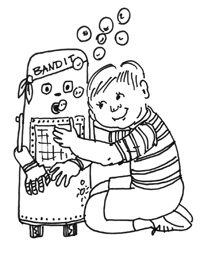STRANGEBUTTRUE- Aye, robot: How they help kids and crones

DRAWING BY DEBORAH DERR McCLINTOCK
Q. In this age of robots, who are "carebots" caring for? –R.T.D.Too
A. They're programmed to help with the elderly or stroke victims or autistic children, says robotocist and neuroscience professor Maja Mataric in The Robotics Primer.
A robot named Bandit excels at blowing bubbles, making odd sounds, and mimicking the movements of children with autism or related disorders, winning them over better than most human caregivers, says Susan Karlin in IEEE
Spectrum magazine. After a presentation, the kids will invariably want to meet Bandit, which quietly collects behavioral data in order to predict, for instance, when a child is about to stop exercising. Socially assistive robots also help kids overcome extreme shyness or manage attention deficit or hyperactivity disorders.
During the months right after a stroke, adds Mataric, a patient has the best chance of avoiding permanent disability, but only if she properly exercises. Hands-on rehabilitation robots like Thera help guide patients through prescribed exercises, all the while providing coaching and spoken encouragement to aid recovery. When Pearl the Nursebot roams an eldercare home, she helps residents find their way to the dining room, TV room, etc. Studies show that those with a pet or a plant tend to feel happier and live longer, but since the elderly often overlook the necessary feedings, robots can be effective substitutes.
Q. Let's hear it for dogs and dog-lovers! But then what exactly are we cheering for? –C. Stuart
A. The number of dogs worldwide is estimated at 400 million, roughly the human population of the U.S and Mexico combined, says Rebecca Coffey in Discover magazine. A dog's nose has some 220 million olfactory receptors, about 40 times as many as humans have. Dogs can also hear frequencies up to 45,000 Hz, about twice as high as you- know-who (though far from hearing-champion porpoises at
150,000 Hz). And Fido the nerd will touch his nose to a computer screen showing a picture of another dog but will stay clear of landscape pix.
Apparently, dogs do look like their owners, going by a study at England's Bath Spa University in which people were able to match photos of dogs (out of three) with photos of their owners more than half the time. Finally, another reason to love your boxer: It is used for doggie DNA studies because the breed has a singularly high degree of genetic uniformity.
Three cheers if you were barking up the right tree.
Q. Chernobyl is virtually synonymous with nuclear disaster, costing an estimated 16,000 lives and over $200 billion. Was it also a disaster for the region's wildlife? –V. Putin
A. Not unambiguously so, for one of the great puzzles to scientists afterward has been the region's thriving and even expanding populations of species such as wild boar, moose, otters, waterfowl and rodents, says Daniel Botkin in Environmental Science: Earth as a Living Planet.
This has happened in spite of radioactive contaminated soils, vast destruction to vegetation within a 7-km radius, decreased tree growth, and even documented increased genetic mutation rates for the animals themselves.
But these rates appear not to have crippled the animal populations. How this happened is unclear, but it is possible other species have benefitted in some ways as humans were driven from the area. Just as with the mammalian upsurge in the wake of the demise of the dinosaurs, the moral here might be that it's an ill eco-wind that blows nobody any good.
~
Send Strange questions to brothers Bill and Rich at [email protected]
#
1 comment
For a look at the future of robotics in warfare go to YOUTUBE and type "The Big Dog". Also read "Wired for War" author Singer. Couple these machines with an autonomous ability to fight and we will have problems.
Terminator is not fiction anymore......